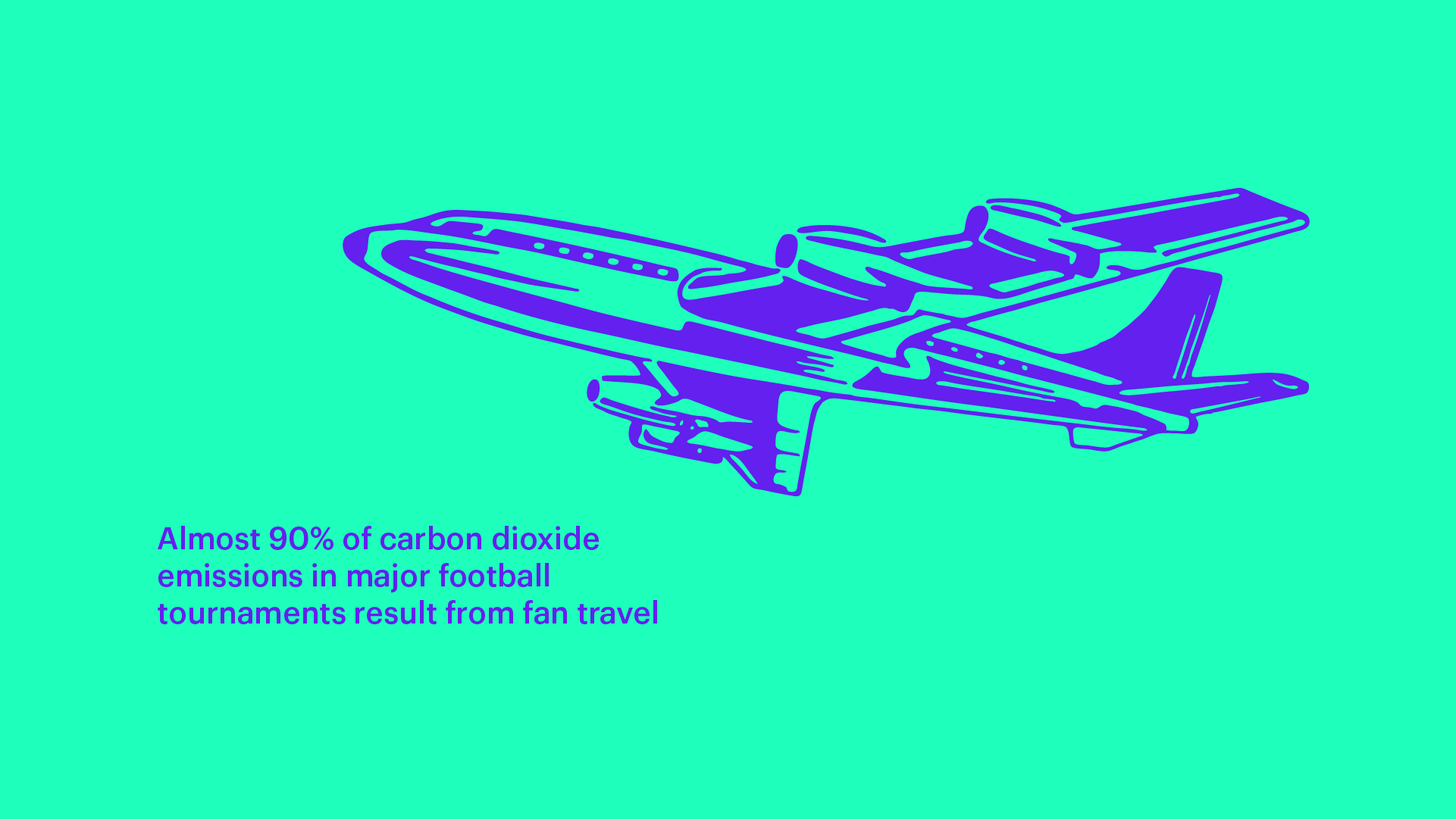
Ioannis Konstantopoulos: “Almost 90% of carbon dioxide emissions in major football tournaments result from fan travel”
Ioannis Konstantopoulos is an FNS researcher at the University of Lausanne and a consultant on sustainability and viability in sport. He participates in ETERON’s FootballON: More Than Goals project, speaking about the climate challenges facing the football industry, the difficult balance between financial benefit and a better environmental footprint for teams with the 2026 World Cup in mind, and the new “green” challenges in football.
During the major floods in Valencia in October 2024, the football team used the “Mestalla” stadium as a point of assistance for flood victims. Will we see stadiums being used more often as such spaces, especially as extreme weather events increase?
Yes, this will definitely happen. However, there are two facts in relation to this: the first is that we are not only talking about climate change, but also about the use of stadiums in various periods of crisis, such as the coronavirus pandemic, when many stadiums were converted into reception and treatment areas for people infected with the virus. We had a similar example with immigration, in areas with increased migratory flows.
The second fact, and perhaps the most important, is that we cannot say that stadiums are safe spaces against extreme weather events. Especially in England, there are many examples where, after heavy storms, stadiums became lakes. So I am not sure whether stadiums are the right place to host and house flood victims or whether the stadiums themselves are ultimately experiencing the consequences of these phenomena.
At the 2022 World Cup in Qatar, there was for the first time extensive press coverage on the issue of extreme heat and the health effects on stadium construction workers and athletes. Is there a regulatory framework for the management of such climate conditions by football federations or is it a completely new field of action?
It is a completely new field of action and there is no regulatory framework at a global level, at least as far as I know. Of course, if a country’s football federation has a framework, a policy up to what temperature, for example, training will be allowed and matches will be held, this concerns the federation itself, the country itself, and is of a local nature.
There are also two components to this issue: The first concerns athletes and what happens during periods of extreme heat. In football, whenever adaptation strategies are followed by international bodies, the scheduling of matches changes, such as in the 2022 World Cup in Qatar where the tournament was held in November-December and not July. There are also smaller changes in scheduling, such as in tennis and the Australian Open, where some games are postponed to the next day because the temperature has reached 43-45 degrees Celsius. In an overall context, the approach followed is per case or per sport.
And the second component? What does it have to do with?
The second component has to do with workers, with the responsibility for implementing policy and making decisions falling under national legislation without requiring the decision of an international body. When there is a gap in the legislation, as in Qatar for example, the workers who have lost their lives due to working conditions were not only working in the construction site of the stadiums, but also in other constructions, in other projects, in skyscrapers, etc.
This specific issue has taken on great dimensions due to the impact that a World Cup has – and this is very positive as such an organization contributes to making changes and bringing such issues to the surface. Undoubtedly, the problems related to the health of workers are very important, they are issues that are worsening and the respective legislation must be adapted according to the climatic conditions in order to protect workers.
The increase in club and national team matches, especially in men’s football, is leading to more polluting conditions for the environment. Is there a way to find a balance between the financial benefits for clubs and associations and a better environmental footprint?
This is a very difficult question that goes to the heart of the problem. If we want to link sustainability to a path of, say, degrowth or post growth, we cannot continue to grow in this way and that growth is associated with a greater environmental footprint, then the direct answer is no.
Almost 90% of carbon dioxide emissions in major football tournaments arise from the travel of fans. This means that more matches cause more travel and in turn more polluting conditions for the environment. This is a given.
Is there a solution to this, however? Can this situation change?
There are various strategies that are being used and will be used more, which make the debate a little more interesting. For example, in a recent meeting we had with the FIFA Sustainability Department, it was discussed that in the next World Cup in 2026 in the USA, Canada and Mexico, an attempt will be made to stimulate the local fan community and not to have the majority of fans come from Europe and the rest of the world. In other words, to support the local fan base in the three hosting countries.
If we take the theoretical scenario that the Greek National Team can compete in the tournament and give a game to each of the three countries, instead of having, for example, Greeks who will follow the team by traveling, you will have many locals, either Americans or Greeks living in the USA to watch the game. In this light, you can ensure that you will have more games and at the same time reduce the environmental footprint. In this case, local participation in stadiums and matches should increase, and this has to do with many other factors, such as the cost of tickets, for example.
This all sounds interesting. Is there another strategy, another approach to this issue?
Yes, there is another strategy that was followed at the Euro in Germany in the summer of 2024 and it concerns creating conditions so that distances are reduced as much as possible. The group, for example, where four national teams play, is located in a specific geographical area, travel and movement are limited, distances are also reduced, with ultimately positive consequences for the environment.
Accordingly, this could also happen in the Nations League, where e.g. Greece instead of competing with Scotland, a group for the Balkan national teams or a group for Southern Europe should be created, the geographical extent of travel and participants should be limited and in this way distances should be reduced, even if more games are played, people should travel in more environmentally friendly ways, the car, the bus, the train should be used and you should not have to take one or two flights to watch a game.
At the same time, however, how will you reduce or limit those who want to travel, all the Europeans who will want to travel from Europe to the other side of the Atlantic to watch the 2026 World Cup up? What would you do in this case?
With the current conditions, you cannot prevent them. Perhaps when FIFA and all the major football tournaments need to catch up with the goals that have been set for the environment, when we get closer to the time point of achieving the goals (i.e. 2030), these organizations will take stricter measures. Therefore, 20 years from now FIFA may tell you that fans will not be able to travel long distances to watch the World Cup. However, this is unrealistic at the moment.
What I see for the future is that there will be some obstacles, some “disincentives”, of an economic or other nature, that will make the trip difficult, and correspondingly incentives will be given to the citizens of the organizing countries that will make it much easier to watch the games. So far we see the opposite happening, that the major football federations want the world to travel regardless of distances, to promote multiculturalism and the tournament itself as a whole.
Can clubs develop new sources of revenue linked to sustainability or invest in green technologies?
It is a question that those of us who work as consultants in this area have tried to answer. Sustainability concerns many categories and many levels (e.g. water, renewable energy, waste management, spectator travel, etc.). and many of them such as energy or waste management can be new sources of revenue for clubs.
Another factor is the degree of involvement, the degree of participation of young fans, Gen Z, the new generation of fans, in a club or an organization. In this context, many studies have shown that younger generations participate more actively in a big event, in a big match, and this is based on the digitization of the experience and the data around the match or a tournament, the players, etc.; on the other hand, it also has to do with the values - environmental and social – of a team.
Overall, the answer to the question is yes, although it is by no means a self-evident or given process. The adoption of sustainability policies may bring new sources of revenue, however, this is happening and can continue to happen through many different ways.




